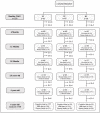Infant Formula Supplemented With Milk Fat Globule Membrane, Long-Chain Polyunsaturated Fatty Acids, and Synbiotics Is Associated With Neurocognitive Function and Brain Structure of Healthy Children Aged 6 Years: The COGNIS Study
- PMID: 35356726
- PMCID: PMC8959863
- DOI: 10.3389/fnut.2022.820224
Infant Formula Supplemented With Milk Fat Globule Membrane, Long-Chain Polyunsaturated Fatty Acids, and Synbiotics Is Associated With Neurocognitive Function and Brain Structure of Healthy Children Aged 6 Years: The COGNIS Study
Abstract
Background: Adequate nutrient intake during the first few months of life plays a critical role on brain structure and function development.
Objectives: To analyze the long-term effects of an experimental infant formula (EF) on neurocognitive function and brain structure in healthy children aged 6 years compared to those fed with a standard infant formula or breastfed.
Methods: The current study involved 108 healthy children aged 6 years and participating in the COGNIS Study. At 0-2 months, infants were randomized to receive up to 18 months of life a standard infant formula (SF) or EF enriched with milk fat globule membrane (MFGM), long-chain polyunsaturated fatty acids (LC-PUFAs) and synbiotics. Furthermore, a reference group of breastfed (BF) infants were also recruited. Children were assessed using neurocognitive tests and structural Magnetic Resonance Imaging (MRI) at 6 years old.
Results: Experimental infant formula (EF) children showed greater volumes in the left orbital cortex, higher vocabulary scores and IQ, and better performance in an attention task than BF children. EF children also presented greater volumes in parietal regions than SF kids. Additionally, greater cortical thickness in the insular, parietal, and temporal areas were found in children from the EF group than those fed with SF or BF groups. Further correlation analyses suggest that higher volumes and cortical thickness of different parietal and frontal regions are associated with better cognitive development in terms of language (verbal comprehension) and executive function (working memory). Finally, arachidonic acid (ARA), adrenic acid (AdA), docosahexaenoic acid (DHA) levels in cheek cell glycerophospholipids, ARA/DHA ratio, and protein, fatty acid, and mineral intake during the first 18 months of life seem to be associated with changes in the brain structures at 6 years old.
Conclusions: Supplemented infant formula with MFGM components, LC-PUFAs, and synbiotics seems to be associated to long-term effects on neurocognitive development and brain structure in children at 6 years old.
Clinical trial registration: https://www.clinicaltrials.gov/, identifier: NCT02094547.
Keywords: LC-PUFAs; MFGM; breastfeeding; cognition; early nutrition; infant formula; neuroimaging; synbiotics.
Copyright © 2022 Nieto-Ruiz, García-Santos, Verdejo-Román, Diéguez, Sepúlveda-Valbuena, Herrmann, Cerdó, De-Castellar, Jiménez, Bermúdez, Pérez-García, Miranda, López-Sabater, Catena and Campoy.
Conflict of interest statement
RD-C and JJ are employees of Ordesa Laboratories S.L., company that have funded in part the COGNIS project. The remaining authors declare that the research was conducted in the absence of any commercial or financial relationships that could be construed as a potential conflict of interest.
Figures


Similar articles
-
Association study between hypothalamic functional connectivity, early nutrition, and glucose levels in healthy children aged 6 years: The COGNIS study follow-up.Front Nutr. 2022 Oct 12;9:935740. doi: 10.3389/fnut.2022.935740. eCollection 2022. Front Nutr. 2022. PMID: 36313089 Free PMC article.
-
Visual, cognitive, and language assessments at 39 months: a follow-up study of children fed formulas containing long-chain polyunsaturated fatty acids to 1 year of age.Pediatrics. 2003 Sep;112(3 Pt 1):e177-83. doi: 10.1542/peds.112.3.e177. Pediatrics. 2003. PMID: 12949309 Clinical Trial.
-
The Effects of an Infant Formula Enriched with Milk Fat Globule Membrane, Long-Chain Polyunsaturated Fatty Acids and Synbiotics on Child Behavior up to 2.5 Years Old: The COGNIS Study.Nutrients. 2020 Dec 15;12(12):3825. doi: 10.3390/nu12123825. Nutrients. 2020. PMID: 33333767 Free PMC article. Clinical Trial.
-
The role of polyunsaturated fatty acids in term and preterm infants and breastfeeding mothers.Pediatr Clin North Am. 2001 Feb;48(1):173-88. doi: 10.1016/s0031-3955(05)70292-3. Pediatr Clin North Am. 2001. PMID: 11236724 Review.
-
Arachidonic Acid in Human Milk.Nutrients. 2020 Feb 27;12(3):626. doi: 10.3390/nu12030626. Nutrients. 2020. PMID: 32121018 Free PMC article. Review.
Cited by
-
Milk metabolite composition of a semi-captive population of Asian elephants.R Soc Open Sci. 2024 Oct 30;11(10):240930. doi: 10.1098/rsos.240930. eCollection 2024 Oct. R Soc Open Sci. 2024. PMID: 39479244 Free PMC article.
-
Association study between hypothalamic functional connectivity, early nutrition, and glucose levels in healthy children aged 6 years: The COGNIS study follow-up.Front Nutr. 2022 Oct 12;9:935740. doi: 10.3389/fnut.2022.935740. eCollection 2022. Front Nutr. 2022. PMID: 36313089 Free PMC article.
-
In vitro Digestion Characteristics of Hydrolyzed Infant Formula and Its Effects on the Growth and Development in Mice.Front Nutr. 2022 Jun 24;9:912207. doi: 10.3389/fnut.2022.912207. eCollection 2022. Front Nutr. 2022. PMID: 35811942 Free PMC article.
-
Nutritional Quality Implications: Exploring the Impact of a Fatty Acid-Rich Diet on Central Nervous System Development.Nutrients. 2024 Apr 8;16(7):1093. doi: 10.3390/nu16071093. Nutrients. 2024. PMID: 38613126 Free PMC article. Review.
-
Diet Supplemented with Special Formula Milk Powder Promotes the Growth of the Brain in Rats.Nutrients. 2024 Jul 9;16(14):2188. doi: 10.3390/nu16142188. Nutrients. 2024. PMID: 39064631 Free PMC article.
References
Associated data
LinkOut - more resources
Full Text Sources
Other Literature Sources
Medical
Research Materials
Miscellaneous

